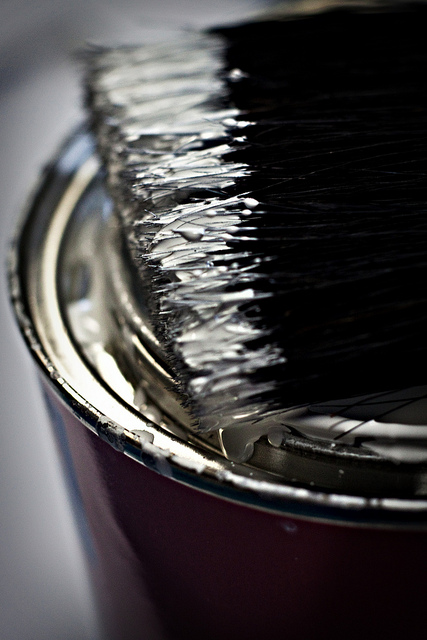Many homeowners like to take on a few do-it-yourself projects. Painting is a popular choice because it seems easy, that is, until you get knee deep into the project. Many times people get half way through their weekend painting spree and wish they had called in a pro. Maybe it’s because they’re having bad luck, they’re not following the simple steps, or they’re trying to cut corners. One reason many people end up with lack luster paint finishes is because they’re using residential painting tools instead of the same tools the pros use. If you’re simply updating the color of one room, the cost of these tools may not be worth it to you. If you’re looking to paint a big project, you might mull over adding some good tools to your arsenal or better yet, call in a professional. Paint is one of those projects that you could do yourself, but the question becomes, should you?
Prep Tools
A professional painter has spent many years learning the art of working smarter, not harder. Often times, this comes in the form of prepping the area before you crack open the can of paint. Some of the best residential painting tools don’t paint; they help the painter prepare for painting. Spending some extra time prepping the room or area you’re about to update could save you time and effort.
Clean Slate: Before you pull out your residential painting tools, you need to start with a clean slate. It’s important to make sure you clear out the room before you start to paint. An ideal project is an empty home or room. If you have large furniture that you can’t move out of the room easily, try and pack as tight as you can into the center of the room. You need plenty of room to work in the perimeter of the room. If you’re painting the ceiling, you don’t want anything in the room, even if it’s covered. A professional painter will use good quality drop cloths. You don’t want a fabric that will allow dropped paint to soak through. Your local home improvement store might offer you some cheap plastic wrap. Just remember, plastic wrap needs to be taped down. Some of it is also very thin and easily torn.
Tape it Up: A pro will use good quality painter’s tape. It’s one of the easier residential painting tools to find. There are several brands and price points available at your local home improvement store. A professional painter knows how to make the tape work for them while you could end up tangled in a sticky mess. A professional painter will tape over anything they might not want to get painted like light switches, outlets, and window frames and molding. A newer product on the market helps take the pain out of painting windowpanes. It’s a roll-on wax product that protects your glass from paint. When the paint dries, just buff the wax off and you have a perfect finish.
Tricks of the Trade: A professional knows how to prep the walls. They’ll spend time repairing cracks and nail holes with putty. Once it dries, a light sanding will make the surface smooth. Then, they will give the walls a light cleaning with a damp cloth to knock off the dust and dirt. New paint can showcase dust and other imperfections on a surface. A pro will spend a few minutes prepping the surface to save time later. Once you’ve done that, you can put your residential painting tools to work to get the job knocked out faster.
Residential Painting Tools
It’s in the Bucket: One of the best residential painting tools to have on hand includes an easy to manage painting system. A pro needs a bucket he or she can easily carry and work out of while painting. Many times, they’ll buy paint in a five-gallon bucket because it’s less expensive. Chances are, a big project will need several gallons of paint. Painting out of a five gallon bucket isn’t easy so they need a bucket or system they can easily use. Many homeowners who choose to do the painting themselves end up pouring paint into metal or plastic trays, but a pro knows this is an extra step and a waste of paint.
1. Pros may use a smaller bucket they can easily carry or hook to a chair or ladder.
2. They can use a rolling screen submerged in a larger five-gallon bucket.
3. Or they may choose an electric painting system that pumps paint straight from the bucket to roller.
Roll with the Punches: Your finish is only as good as your roller or brush. To get a professional finish, your residential painting tools should include high quality rollers. The best rollers are made from lamb’s wool or micro fiber. If you buy a less expensive roller from your nearby home improvement store, you will want to wash it with dish detergent first and let it dry completely. This will remove any stray fibers that could end up speckling your finish. A pro’s rollers will last quite a while. Remember, the longer the nap on a roller, the more texture you’ll see in your finish.
Spray This: If a professional is working with a clean slate, meaning, an empty house, he or she might choose to use a paint sprayer. This moves the job faster with a more uniform finish. You can try finding a paint sprayer at a nearby store, but it will not be the same sprayer a pro would use. Most consumer paint sprayers do a fair job, but they can easily malfunction and clog. You might spend more time cleaning it and trying to roll out the splatters on the wall than you do actually spraying. If you really want that perfect finish from residential painting tools, you might consider forgetting a do-it-yourself job this time and call in a professional to do the job right.
Finishing Tools
Brush It: Your residential painting tools should also include a really nice set of brushes. They might have a wide range of widths. It’s important to spend a little extra money on your paintbrushes so they will hold up well for several jobs. A cheap brush could come apart in the middle of painting out your trim. A pro will have different high quality paintbrushes for interior jobs and a separate set for exterior. They might also have separate sets for water-based paints and oil based paints since the clean up process is so different with each.
Scrape It: Your residential painting tools should also include a good scraper or scrape blade. This isn’t necessarily for painting, but for cleaning up and helping give the pro a clean edge look. You can use a scrape blade to help scrape away any leftover paint on windowpanes. You can also use the edge to help protect a hard-to-reach surface you need to paint.
Clean It: Finally, a pro will always have a good cleaning solvent or solution on hand. That’s because a professional painter leaves the home or room in better shape than when he or she arrived. Your residential painting tools should include the same. If you see an accidental spill or splatter of paint, make sure you use your cleaning solution on the stain while it’s still wet. This will give you a better chance of keeping it from setting in and ruining the carpet, furniture, or whatever is now color coordinating with the walls.
The pros have a lot of tricks up their sleeves when it comes to using the best painting tools. They know how to get the job done right and can do so fairly quickly. If you choose to try and take on a painting task yourself, keep these residential painting tools in mind. They will help you keep a lead on your money savings for your makeover.
What residential painting tools do you use? Please comment below
If you got this far you deserve another treat – Wacky Residential Painting Tools that you might have not thought of



